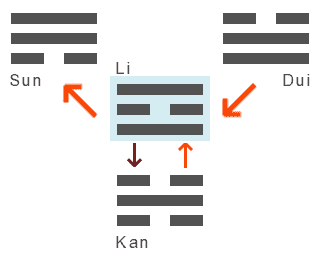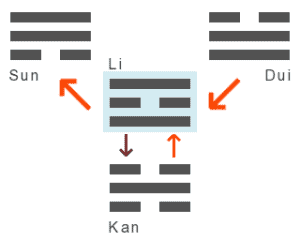What does Li represent?
Li, the fire, represents our ability to differentiate facts, influences, demands, emotions – in essence, the abundance of the world rushing towards us. Without this ability to separate the clear from the unclear, we would be overwhelmed by the chaos of diversity.
However, in order for us to differentiate, we require a criterion. A criterion by which we discern, keeping what we perceive as important and beneficial, and letting go of what we do not desire. What would that criterion be? An insightful phrase can be found in the classics of Traditional Chinese Medicine: “What is good for me to maintain purity in the system?”
My Well-Being as the Criterion
Here we have our criterion, and it is: For me. Myself and my well-being are the criteria by which we should discern. This initially sounds good and straightforward, but upon closer examination, it proves to be challenging. Because this criterion requires that I truly sense myself, identifying where I end and where you begin.
How well do I know myself and my needs? Can I perceive my needs as they arise? Am I willing to give them space, to fulfilled them? No, this does not advocate for selfishness, but for self-care. It is akin to the safety instructions on an airplane: First, you secure your own oxygen mask, then you assist the other passengers. The simple reasoning behind this instruction is that if I am not (or no longer) doing well, I am of no use to anyone.
And What About Us? Does This Us Also Include Me?
These considerations become very tangible when it comes to human interaction, to walking a shared path. I must know who I truly am and what this I needs, in order to advocate for it. Because if I don’t know that, how can collective decisions also encompass me and my desires?
In the classics of Traditional Chinese Medicine, we find various descriptions related to the functional circuit of the Small Intestine (see also King Wen’s Later Heaven: the Small Intestine (SI) is associated with Li). These descriptions emphasize the ability to differentiate and provide the overall system with what is beneficial: Phase Element Fire: Small Intestine
Following the Path of the Dao: What Do I Want?
In the model Follow the Path of the Dao, Li represents one of the two test points. A test point is a tipping point where a movement can abruptly and dynamically change its direction. In the context of the model, Li shifts the focus from the relationship with the world to the relationship with oneself: My ability navigate the external world largely depends on how well and compassionately I treat myself.
In the spirit of self-exploration, the following questions can be formulated:
- Do I sense myself? Who am I, what defines me? What are my needs?
- Where do I stand in this matter, what do I need in this context?
- Am I willing to advocate for my interests? Or do I shy away from asserting my needs? What do I fear?
- Can I handle the disappointment of others when I assert my needs? What (negative) consequences do I fear? What positive consequences could arise if I stand up for my needs?
What does Li emerge from?
Within a hexagram Li develops either from Dui or Kan (exception: the hexagram begins with Li / Li is the lower trigram). The red arrows indicate that a (solid) yang line is added to each previous trigram. Yang symbolizes energy, activity. If we separate diversity, if we differentiate between “clear” and “unclear”, then this is an active, willful process.
Li emerges from Dui, the Lake
Dui, the lake, represents receiving and giving, the opening of our own boundaries. But by opening ourselves to the abundance of the world, we also risk being overwhelmed by it. Li supports us in staying true to ourselves and being clear in our interaction with the world. Because Li provides us with a criterion for differentiation: ourselves. This way, we can recognize what is important and maintain our ability to take action.
Examples of hexagrams where Li emerges from Dui → here.
Li emerges from Kan, the Water
Kan, the water, represents our primordial grounds, the essential and enduring aspect of our individual existence that transcends generations. Here is where our primal trust resides, but also our primal fear. Li translates this fundamental essence into the reality of our everyday life. Sometimes gut feelings are an opportunity, and sometimes they become an obstacle.
Examples of hexagrams where Li emerges from Kan → here.
What does Li develop into?
Within a hexagram Li develops either into Sun or Kan (exception: the hexagram ends with Li / Li is the upper trigram.
Li develops into Kan, the Water
Kan, the water develops when a (broken) yin line is added (dark arrow; yin symbolizes receptivity). Our ability to differentiate (Li) provides us with a sense of tranquility. When sudden gut feelings, presentiments, or intuitions arise, we can calmly inquire: Where do they come from? What do they mean? What is the nature of this I that I sense?
Examples of hexagrams where Li develops into Kan → here.
Li develops into Sun, the Wind / Tree
Sun, the wind / tree, develops when a (solid) yang line is added (red arrow; yang symbolizes energy, activity). Once we have clarity (Li) about our exact position and what we aim to achieve, we can embark on our journey (Sun, the wind / tree). From this point onward, even in the face of potential resistance, we can calmly and thoughtfully pursue our goal.
Examples of hexagrams where Li develops into Sun → here.
References
Phase Element: Fire
Functional Circuit: Small Intestine (SI)
Modern Interpretation
Clear discernment, purification, separation
Traditional Interpretation
Adherent; bright, luminous, lucent, lucid; careful
Direction: upwards
Interpretation: A clear vision brings inner peace in the midst of movement; eventually only an appearance is detected and things are not being screened deeply enough





